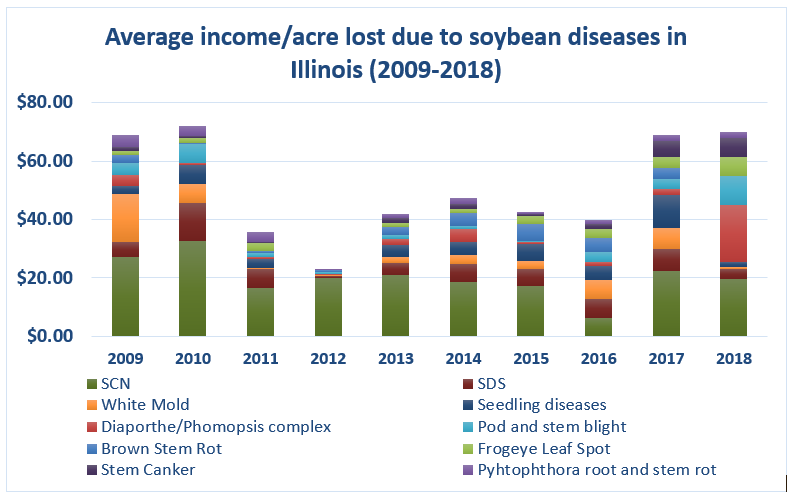ILSOYADVISOR POST
8 Key Soybean Diseases (and 1 Worm) To Watch Out For (and What To Do About Them)
According to the Crop Protection Network, soybean producers in Illinois lose just under half a billion dollars annually to diseases. This equates to an average of $51/acre per year across the state over the past decade. Understanding what these diseases are and how to control them can improve the profitability of your operation.
Figure 1. Annual loss per acre to soybean diseases in Illinois. Data source: Crop Protection Network Disease Loss Calculator
Early Season Diseases
Many pathogens attack soybeans early in the growing season. The most significant are Phytophthora, Fusarium, Pythium and Rhizoctonia. Each of these diseases can cause pre- or postemergence damping off (death of very young plants). Although the symptoms of these diseases are somewhat similar, the conditions that favor their development differ in some ways. Pythium, Fusarium and Phytophthora are more likely to develop when soils are waterlogged and chilly after planting. Rhizoctonia prefers warm dry soils and is more likely to develop in sandy fields.
Although these diseases generally show up early in the season, they continue to cause problems throughout the year. Stressful growing conditions can exacerbate the effects of minor infections. The best way to combat seedling diseases is to utilize a combination of resistant genetics and fungicidal seed treatments. Symptoms can also be worse in compacted fields, so avoiding soil compaction can help with disease mitigation.
Mid-Season Diseases
The two most important diseases that show up in the middle of the growing season are frogeye leaf spot (FLS) and white mold. Although the development of both of these diseases is increased in rainy and humid conditions, FLS prefers warmth and white mold spreads more rapidly in cool weather. Both diseases can cause significant yield loss in highly infected fields. FLS is more of a problem in the southern part of the state and white mold occurs to a greater extent in the north.
Although the effects of these diseases can be lessened with foliar fungicide applications, some races of FLS have been documented to have resistance to strobilurin chemistries. It is always a good idea to use a fungicide that has active ingredients from at least two fungicide classes. With white mold, fungicide application timing is important; the pathogen infects through flowers, so R1 timing is critical to slow development of this disease.
Late Season Diseases
In 2018, a disease that had historically caused little problem in Illinois accounted for the most yield loss of all diseases, an average of nearly $20/acre across the state. The Diaporthe/Phomopsis disease complex was prevalent in many areas. Although the symptoms of this disease show up later in the year, infection actually occurs early in the growing season and is worse when extended wet periods occur after planting. The best way to protect against these diseases is with fungicidal seed treatments. In some cases, resistant genetics may be available.
Sudden death syndrome (SDS) also infects early in the growing season. In fact, the pathogen attacks the seed within days of planting and is favored by compacted, saturated and cool soils. Foliar symptoms occur later in the year, when the area between leaf veins becomes necrotic and the plants seem to die suddenly. In areas of the field where SDS is heavy and appears early in reproductive stages, yield losses can approach 90%. The disease causes significant yield loss across Illinois nearly every year, but can be somewhat controlled with resistant genetics and specific seed treatments such as ILeVO®. Keep in mind that standard fungicidal seed treatments do not provide protection against SDS.
Soybean cyst nematode (SCN) is not a disease, but a microscopic worm that lives in the soil and infests soybean roots. SCN is sometimes referred to as a “silent” yield robber, because there are often no obvious above-ground symptoms of a problem. However, yield losses approaching 40% have been reported in fields with no above-ground visual symptoms. The impact of SCN can be lessened through crop rotation, resistant genetics and certain seed treatments. Control of this pest can also lessen the occurrence and severity of SDS.
Although diseases can cause significant yield loss, the good news is that soybean growers and their partners in the seed and crop protection business have quite a few tools in their toolboxes to combat them. If you have a good idea of what diseases could pop up, either from past field history or soil sampling, you can develop a tailored strategy for combating them on each and every individual field.






Comments
Add new comment